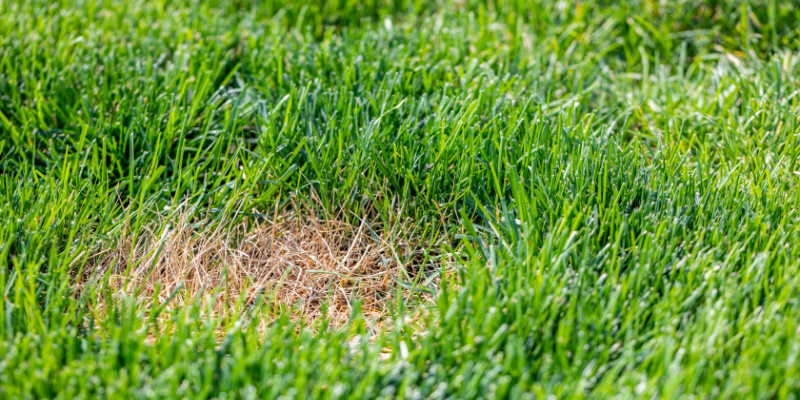Achieving a vibrant lawn is a goal for many homeowners. However, the presence of insects and diseases can quickly turn a lush green landscape into a patchy, brown mess. Understanding why these things affect your yard is crucial in order to combat these issues and restore your lawn’s health effectively. This blog will explore the common causes of insect and disease damage to your lawn and discuss preventive measures and treatment options to help you reclaim a thriving outdoor space.
Insects
Insects can cause significant damage to your lawn, feeding on grass blades, roots, and soil. Here are some common insect pests that may be destroying your grass:
- Grubs
Grubs, beetle larvae, feed on grass roots, causing brown patches as the grass dies. They also burrow into your soil and disturb the smoothness of your lawn. Signs of grub infestation include irregularly shaped brown spots that lift easily, revealing grubs just beneath the surface.
- Chinch Bugs
Chinch bugs are small, black insects that suck sap from grass blades. They tend to target sunny areas near driveways or sidewalks, causing the grass to turn yellowish and eventually brown. Inspect the grass by parting it and looking for small, red, or black bugs near the soil surface.
- Armyworms
Armyworms are caterpillars that can quickly destroy large grass areas by eating grass blades and leaving behind brown patches. Look for signs of chewed grass blades and small, green, or brown caterpillars near the surface.
Diseases
Lawn diseases are typically caused by fungal or bacterial pathogens that thrive under specific conditions. Common lawn diseases include:
- Brown Patch
Brown patch is a fungal disease that causes circular or irregular brown patches on your grass. It thrives in hot, humid conditions and can spread rapidly. Overwatering, poor drainage, and excessive nitrogen fertilization can contribute to its development.
- Dollar Spot
Dollar spot is another fungal disease characterized by small, silver dollar-sized patches of dead grass. It tends to occur in warm, humid weather and can spread rapidly during periods of high humidity and low nitrogen levels in the soil.
- Powdery Mildew
Powdery mildew is a fungal disease that forms a white or gray powdery substance on the grass blades. It thrives in warm, dry conditions and can weaken the grass, leading to brown patches.
Preventive Measures and Treatment Options
1. Proper Lawn Care Practices
- Regular Mowing: Maintain proper mowing height for your grass type and avoid cutting off more than one-third of the grass blade in a single mowing which helps promote healthy growth and reduces stress on the lawn.
- Adequate Watering: Water deeply but infrequently, preferably early in the morning, to allow the grass to dry before nightfall. This prevents the development of favorable conditions for disease-causing pathogens.
- Fertilization: Use a balanced fertilizer with the appropriate nutrient ratios for your grass type. Avoid excessive nitrogen fertilization, as it can weaken the grass and make it more susceptible to disease.
2. Integrated Pest Management (IPM)
- Monitoring: Regularly inspect your lawn for signs of insect pests or disease. Early detection allows for prompt treatment and reduces the likelihood of severe damage.
- Natural Predators: Encourage natural predators like birds, beneficial insects, and amphibians that feed on pests. To attract beneficial wildlife, provide habitat elements such as bird feeders, nesting boxes, and water sources.
- Resistant Grass Varieties: Consider planting grass varieties naturally resistant to common pests and diseases in your area.
3. Fungicides and Insecticides
- Fungicides: If lawn diseases are persistent and damaging, consider using fungicides. Consult a professional for advice on the appropriate fungicide and application methods for the specific disease.
- Insecticides: In severe cases of insect infestation, targeted insecticides may be necessary. Choose insecticides designed for the specific pests affecting your lawn, and follow the instructions carefully to minimize environmental impact.
Understanding the causes of insect and disease damage to your lawn is the first step in effectively combating these issues. By implementing preventive measures and adopting proper yard care practices, you can create an environment that discourages pests and promotes the health of your grass. If you need help restoring your lawn to its full potential, call Weed Busters today. We will aid you in achieving a beautiful and thriving outdoor space to enjoy.

